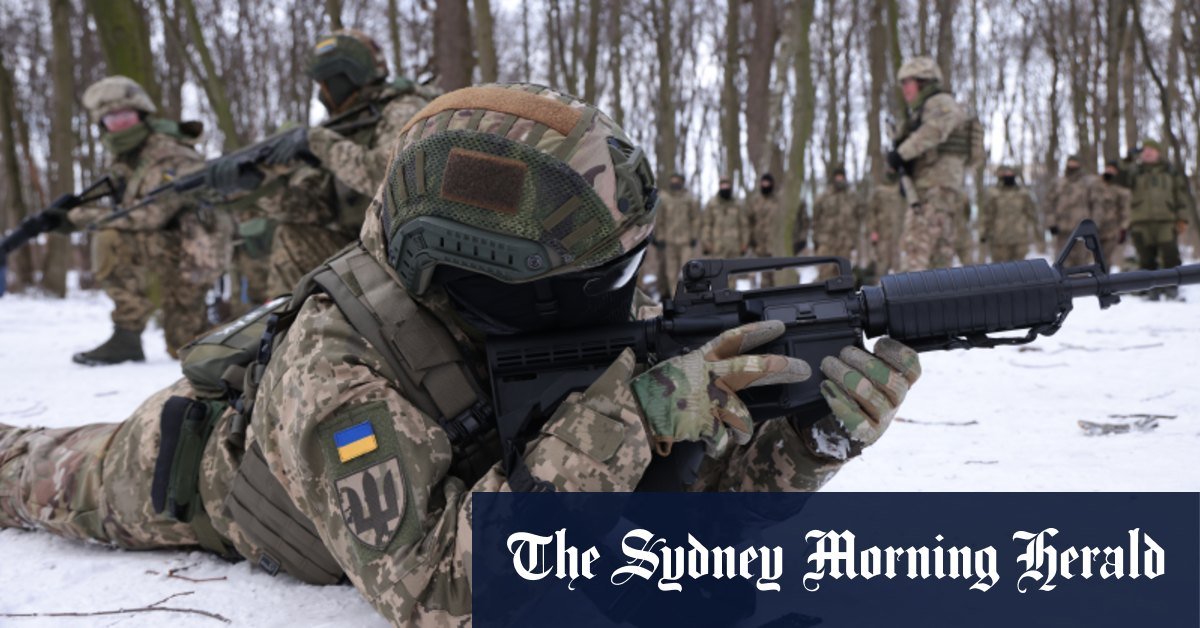By Hanna Arhirova
Kyiv: When Russian tanks rolled into Ukraine in February 2022, the conventional wisdom was that the capital, Kyiv, would soon fall and the rest of the country wouldn’t last long against a much larger enemy.
Instead, it was that narrative that quickly collapsed. The Ukrainian army proved it could slow the advance of Russia’s forces and, if not drive them out completely, then – with enough support from the West – at least forestall defeat.
But nearly three years later, the outlook is again grim. Russia is expending huge amounts of weaponry and human life to make small but steady territorial gains on the near one-fifth of Ukraine it already controls. Ukraine, meanwhile, is struggling to minimise losses, maintain morale and convince allies that, with more military aid, it can turn the tide.
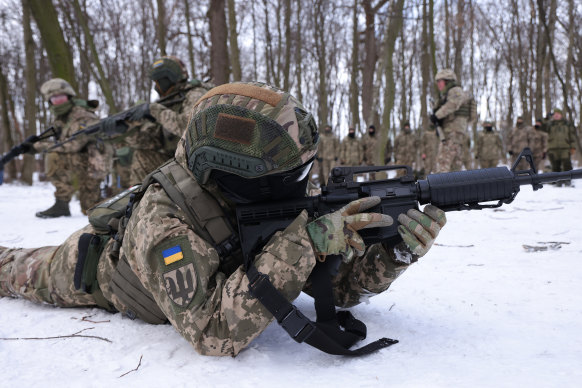
Civilian participants in a Kyiv Territorial Defence unit train in a forest near Kyiv anticipating the Russian invasion.Credit: Getty Images
Thousands of Ukrainian citizens have died, more than six million live as refugees abroad and the population has fallen by a quarter since Kremlin leader Vladimir Putin ordered the invasion by land, sea and air that began Europe’s biggest conflict since World War II.
Military losses have been catastrophic, although they remain closely guarded secrets. Public Western estimates based on intelligence reports vary widely, but most say hundreds of thousands have been killed or wounded on each side.
Tragedy has touched families in every corner of Ukraine, where military funerals are commonplace in major cities and far-flung villages, and people are exhausted by sleepless nights of air raid sirens and anguish.
Loading
As this brutal war of attrition grinds towards its 1000th day on November 20, neither side seems eager to negotiate. US President-elect Donald Trump has said he could quickly end the war, though it is unclear how, or in whose favour he might tip the scales.
This backdrop appears to be driving Russia’s strategy in eastern Ukraine, according to Phillips O’Brien, a professor of strategic studies at the University of St Andrews, Scotland. Trump could try to force an end to the war by halting the supply of weapons to Ukraine, he said.
“If Trump cuts aid to Ukraine and a ceasefire leads to a frozen conflict, Russia wants to secure as much territory as it can now,” O’Brien said.
On Monday, President Joe Biden’s administration authorised for the first time, the use by Ukraine of US-supplied long-range weapons to strike deep inside Russia. Some analysts believe this will allow Ukraine to maintain a hold on Russia’s Kursk region and use it as a bargaining chip in any ceasefire negotiations.
For Ukraine, the key to any ceasefire would be guarantees from the West that it won’t allow Russia to reinvade in the future. Otherwise, O’Brien said, “a ceasefire is a recipe for constant instability in Europe.”
Russia is advancing slowly but steadily in eastern Ukraine
On February 24, 2022, Putin announced he had launched a “special military operation” in eastern Ukraine, designed to liberate Russian speakers living there, and propel the “demilitarisation and denazification” of the country, he said. Shortly after, missiles targeted several cities across Ukraine, and troops invaded from land and sea, resulting in street battles and a population exodus.
Reuters reported Ukrainian forces battled Russian invaders through the day in Ukraine’s capital and elsewhere in the country, and at least 70 people were reported killed. “The assault brought a calamitous end to weeks of fruitless diplomatic efforts by Western leaders to avert war over Russian demands for a redrawing of post-Cold War security arrangements in Europe,” Reuters wrote.
In the war’s first year, Ukraine lost huge amounts of territory – but it also achieved notable victories. It resisted a much larger adversary with superior air power to survive as an independent country, and it reclaimed some land through gutsy counteroffensives, giving the underdog – and its wealthy allies – the confidence to stay in the fight.
In the second year, which was punctuated by Ukraine’s devastating loss of Bakhmut and a failed major counteroffensive, the armies essentially fought to a standstill along a 1000-kilometre front line. Towards the end of that year, the US Congress delayed the approval of a $US61 billion ($94 billion) package of aid for weapons, and economic and humanitarian assistance.
With Ukraine’s ammunition dwindling, its outlook deteriorated significantly as the war’s third year began. In February 2024, the town of Avdiivka fell after months of airstrikes by Russia, which used highly destructive Soviet-era bombs retrofitted with navigation systems.

A Ukrainian soldier inspects a damaged apartment building in war-hit Avdiivka in the Donetsk region on April 12, 2023.Credit: AP
The fall of Avdiivka created a major breach in Ukraine’s defences. When Russia later mounted an assault on the north-eastern city of Kharkiv, Ukrainian troops were stretched further.
A bright spot for Ukraine came in August, when it launched a surprise incursion into Russia. It took – and still holds – hundreds of square kilometres in the Kursk region. While this could be an important chip in any ceasefire negotiations, it hasn’t stopped Russian forces from taking more land in Ukraine’s east.
“The Russians have paid a very high price to keep advancing, but they’re willing to pay that price in lives to gain a few more meters of territory each day,” said Justin Crump, head of the British strategic advisory firm Sibylline.
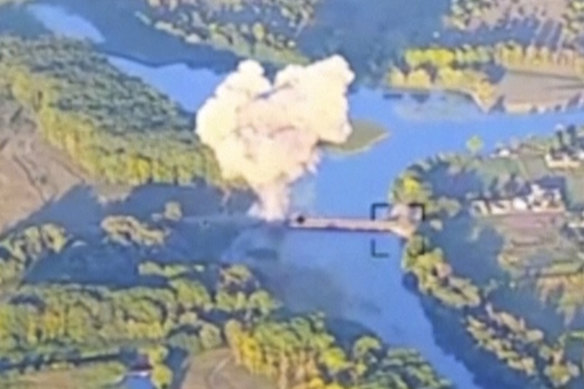
The destruction of a key bridge in Russia’s Kursk region by Ukraine less than two weeks into its stunning cross-border incursion in August, disrupted Russian supply routes and signalled its troops were planning to dig in. Credit: AP
Tens of thousands of soldiers from both countries have been killed since the start of the war in 2022, according to estimates, and the UN says at least 11,700 Ukrainian civilians have been killed.
While the amount of land Russia has gained in 2024 alone – about 2455 square kilometres is equal to less than 1 per cent of Ukraine’s pre-war territory, it is having a psychological impact.
With Ukraine in retreat, “we’ve now returned to a period reminiscent of the [war’s] first months,” said Mykola Bielieskov, an analyst at CBA Initiatives Centre in Kyiv. “This strengthens Russia’s position – not so much militarily, but in terms of morale.”
A war of attrition
To keep its war machine going, Russia – like Ukraine – has turned to allies for help.
Iran supplies Russia with drones and possibly missiles, and North Korea has sent ammunition – and some 10,000 troops, who have been deployed to Russia’s Kursk region.
Putin claimed this year that 700,000 of his troops were fighting in Ukraine. Analysts say Putin would need a much larger force to accelerate Russia’s advance, but that he was unlikely to mobilise more troops because it could stoke internal discontent.
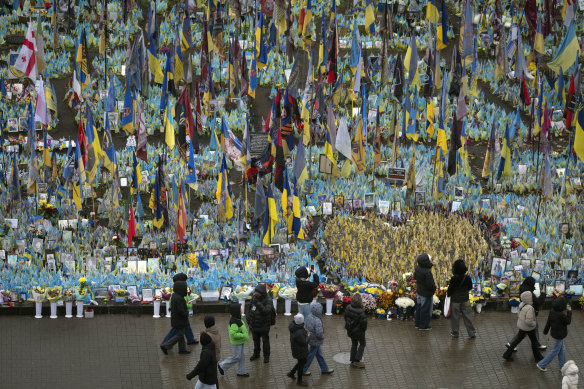
People walk past the memorial to fallen soldiers in Independence Square in Kyiv, Ukraine.Credit: AP
Ukraine’s foothold in Kursk is another complicating factor for Putin.
Captain Yevhen Karas, a Ukrainian commander in Kursk, said the fighting inside Russia is highly dynamic, but he believes it will prove effective in diverting Russia’s attention and resources.
“Even a creeping, retreating front exhausts the enemy significantly,” Karas said.
Ukraine has asked the West for longer-range missiles, as well as its blessing to fire at air bases deep inside Russia. But its allies had so far resisted, wary of escalating tensions with a nuclear-armed Russia.
The US has provided more than $US64 billion in military aid to Ukraine since the start of the war. Soldiers worry about what would happen without sustained American support.
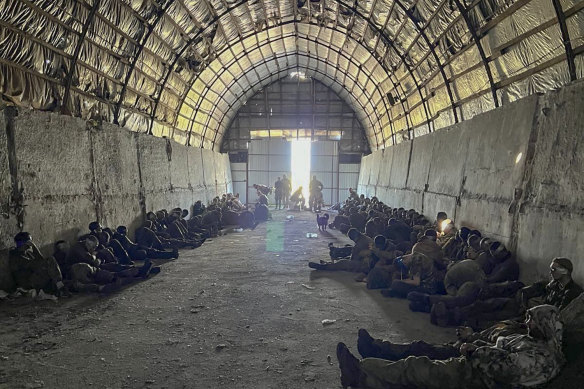
In this photo provided by the Ukrainian Security Service Press Office, more than 100 captured Russian prisoners wait in a shelter in Kursk region, Russia.Credit: AP
“Bravery, heroism, and spirit alone are not enough,” said a Ukrainian soldier in the eastern Donetsk region who spoke on condition of anonymity, in line with military rules.
The soldier estimated that where he is stationed, Russian infantry outnumbers Ukrainian troops 10 to one. As the war drags on and the death toll rises, it has become increasingly difficult for Ukrainian President Volodymyr Zelensky to keep replacing troops.
The US will play a vital role in determining the war’s next direction
What direction the war takes next will depend in large part on how the incoming Trump administration plays its hand.
Trump, who has touted his good relationship with Putin and called the Russian leader “pretty smart” for invading Ukraine, has repeatedly criticised the American backing of Ukraine.
During his only campaign debate with Vice President Kamala Harris, Trump twice refused to directly answer a question about whether he wanted Ukraine to win – raising concerns that Kyiv could be forced to accept unfavorable terms in any negotiations.
Loading
Without security guarantees from the West, Ukraine could find itself vulnerable to future Russian aggression. Analysts say a ceasefire based on the current state of the battlefield would set a dangerous precedent, implying that Europe’s borders are up for grabs through military action – something that hasn’t happened since World War II.
“This would also have a lot of traction in countries like China, India, and elsewhere,” said Richard Connolly, a Russia expert at the Royal United Services Institute in London. “They could present that as a strategic defeat not only for Ukraine, but also for the West.”
As another winter of war approaches, Ukrainian soldiers say they remain resolute.
“We are standing strong, giving it our all, and we won’t surrender,” said a battalion chief of staff in the southern region of Zaporizhzhia. “The most important thing now is not to lose more land.”
AP with Reuters
Get a note directly from our foreign correspondents on what’s making headlines around the world. Sign up for our weekly What in the World newsletter.
Most Viewed in World
Loading
